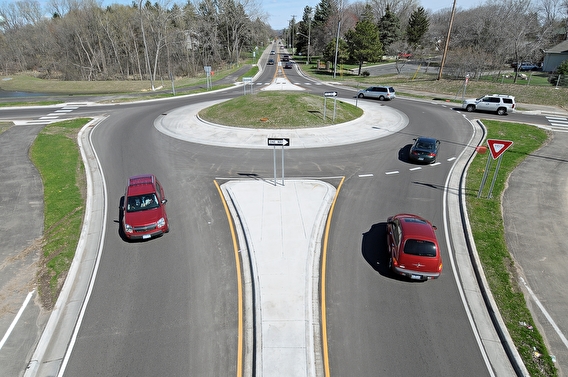By Alan Forsberg, P.E., Retired Blue Earth County Engineer

I recently had the opportunity to attend an excellent session about a cool topic—intersection control evaluation, or ICE, reports—at the City Engineers Association of Minnesota annual conference, as well as discuss these reports with local and state engineers. I would like to share what I learned.
Intersection options and considerations
First, the obvious—where two or more roads meet at the same grade, traffic-control rules or design is needed, or vehicles will run into each other. This has been true since the days of horses.
There are many traffic control options, including some relatively new ones:
- No control, or vehicle on the right has right-of-way by law
- Thru yield
- Thru stop
- All-way stop
- Traffic signal
- Roundabout
- J-turn
- Grade-separation interchange
- And many other recent innovative designs
Which is the best option for a specific intersection? Some important considerations:
- Cost, including initial construction, maintenance, and user-delay costs
- Safety—both crashes and serious injuries
- Environmental quality, natural and cultural resource effects
- Corridor study recommendations
- Priority for through traffic with consideration of functional class for intersecting roads
- Pedestrian and bicycle safety and any other modes of transportation affected such as trucks and rail
- And especially for local roads:
- Public acceptance
- Political acceptance
- Gaps in traffic for driveways and intersecting roads upstream and downstream of the intersection
ICE reports and studies
In the past, warrant studies were used to justify new signal and roundabout intersections. Now these warrant studies are included within the ICE report.
ICE reports are used to develop alternatives, compile relevant data, and analyze alternatives for a recommended design. ICE studies are required for any significant expansion of an existing intersection or change in intersection design, except for no control or two way stop intersections where an ICE report is not needed.
The 2017 MnDOT Intersection Control Evaluation Manual provides guidance on developing an ICE report. A revised manual is under development and should be available late this year (see related story: MnDOT updating ICE manual). ICE reports can be complex, with appendixes typically 50 to 100 pages. When prepared by a consultant, an ICE report may cost $10,000 to $20,000 or more.
The ICE report should include the intersection safety and operation objectives, alternatives reviewed (such as two-way stop, signal light, and roundabout), and rationale for selection of the recommended alternative. Data and analysis typically include traffic projections, safety, user delay, level of service, initial and maintenance cost, and environmental and social effects analysis, plus other considerations such as public acceptance, political acceptance, corridor studies, priority for through and higher functional class roadways, and other relevant considerations. It should Include a preliminary layout of the recommended plan and adjacent access points.
MnDOT as study lead
If one or more legs is a MnDOT road, it is suggested MnDOT take the study lead. The ICE report needs to be signed by the professional engineer responsible for developing the report and the District Traffic Engineer. The District Traffic Engineer may request review and comments by the MnDOT Central Traffic Office. The report is typically prepared three to seven years prior to construction.
Projects using only local road and State Aid funds
However, if only local road and State Aid funds are used, there is more flexibility in data and analysis requirements. These reports are signed by the professional engineer responsible for developing the report and the District State Aid Engineer. The District State Aid Engineer may request review and comments by the District Traffic Engineer.
The reports are typically prepared one to two years in advance of construction. In some cases, only a letter report documenting consideration of alternatives, data compiled, analysis performed, and rationale for selecting an intersection design is needed.
The District State Aid Engineer can approve a roundabout even if warrants are not met based on safety and operational characteristics.
Most local intersections, especially in Greater Minnesota, have been in place for many years and their performance well understood. Proposed design modifications are relatively minor, such as increasing turning radii for larger vehicles and adding a turn lane. After coordinating with the State Aid Engineer it may be determined that no ICE report is needed. In Greater Minnesota MnDOT districts, only a few ICE reports are prepared each year.
Metro and regional center counties
In the Twin Cities metro and regional center counties, however, many intersections will require a full ICE report. (Regional center counties include, for example, Olmsted, St. Louis, Stearns, and Blue Earth.) Considering a signal system may cost about $400,000 and a roundabout $1,500,000, spending one or two years in advance of construction and $10,000 to $20,000 in consultant costs is easily justified to ensure a rational, well-documented intersection design is selected. In some cases, ICE reports have shown the existing intersection design is best.
Start early in the planning process
A good first step—coordinate your project with your District State Aid Engineer early in the planning process to determine whether an ICE report is needed and the level of data and analysis required.